It wasn’t a long walk from Ventosa to Azofra, only 16km, or 10 miles, but it seemed to go on forever. The walk was through miles of vineyards with no shade, up and down and up again.
As we left Ventosa at 7:07 a.m., I chatted with cute blonde Bev from Houston, who I’d met at dinner the evening before. Her daughter was in Peru doing a shamanic journey of transformation with Ayahuasca, a sacred plant medicine revered for its healing and mystical properties. Bev was expecting a phone call from her that morning. She had told me at dinner last night that she had tried mushrooms, which she loved; she would do them again if given the opportunity. I told her of my loved one’s interest in them, and how he’d given me Michael Pollan’s book How to Change Your Mind: What the New Science of Psychedelics Teaches Us About Consciousness, Dying, Addiction, Depression and Transcendence to read. I told her how my loved one reported that he heard voices and believed he was a shaman. She said she believes there is so much out there that we are not aware of and he could very possibly be a shaman! She believes the 20s are a time for figuring things out. I felt hopeful after our conversation.
Ventosa to Túnel N-120 (3.1 km)

Leaving Ventosa 7:39 a.m.
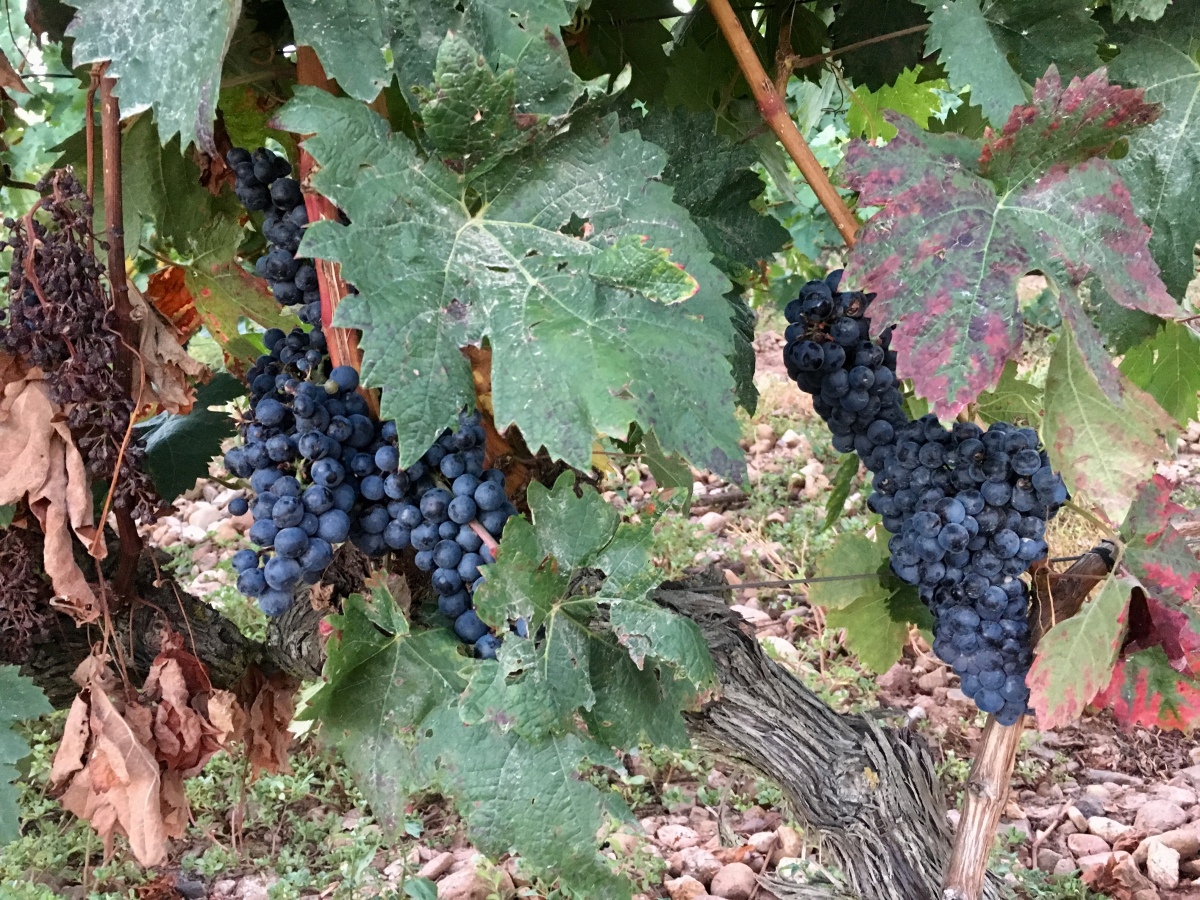
grapevines
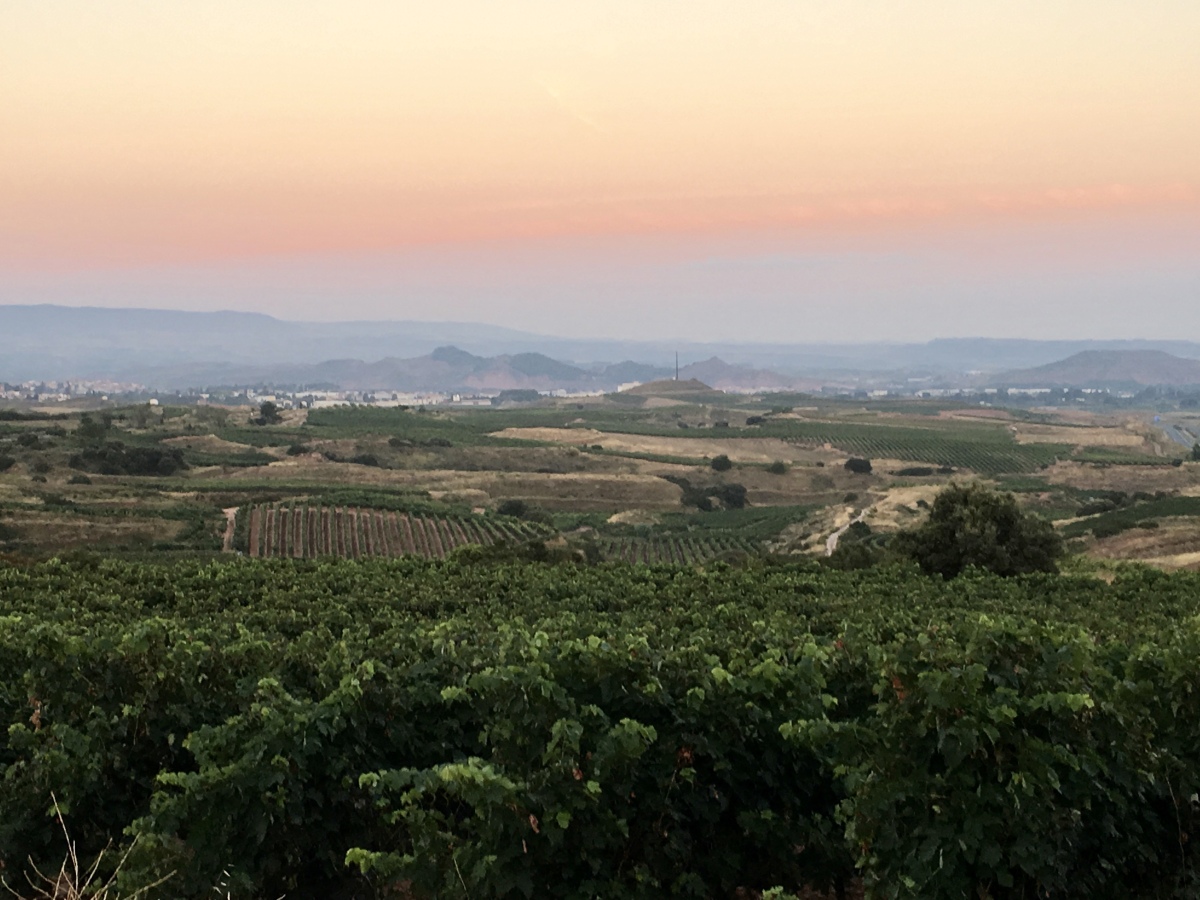
Rioja

vineyards

grapes

Alto de San Antón (8:08 a.m.)

Vineyards
We crested a hill at Alto de San Antón and a while later stopped to admire a reconstructed chozo, a stone hut for storing agricultural implements, near Poyo de Roldán, or Roldán’s Hill. A sign said this was the scene of one of the first legends of the Road to Santiago. It marked the spot where the knight Roldán slew the Syrian giant Ferragut, said to be nine feet tall. His nose span was said to be the “length and strength of four men.”
The fight took place in the esplanade between Nájera’s castle and Alesón’s watchtower. After hours of battle between the two fighters on horseback, Roldán and Ferragut agreed to a truce. The giant told him he had great courage and offered to finish the combat but Roldán rejected the offer.
The battle continued two days between the knights. The giant fell over Roldán trapping him under his two hundred kilos of weight. Roldán believed that Ferragut’s only vulnerable part was his navel. He unsheathed his dagger and plunged it into Ferragut, killing him. This was how the Arabs were forced from Nájera and how Roldán gained his fame as the best warrior of Christianity. An enormous treasure is said to be buried here.
Túnel N-120 to Pasarela río Yalde (4.2 km)

Alesón 8:35 a.m.
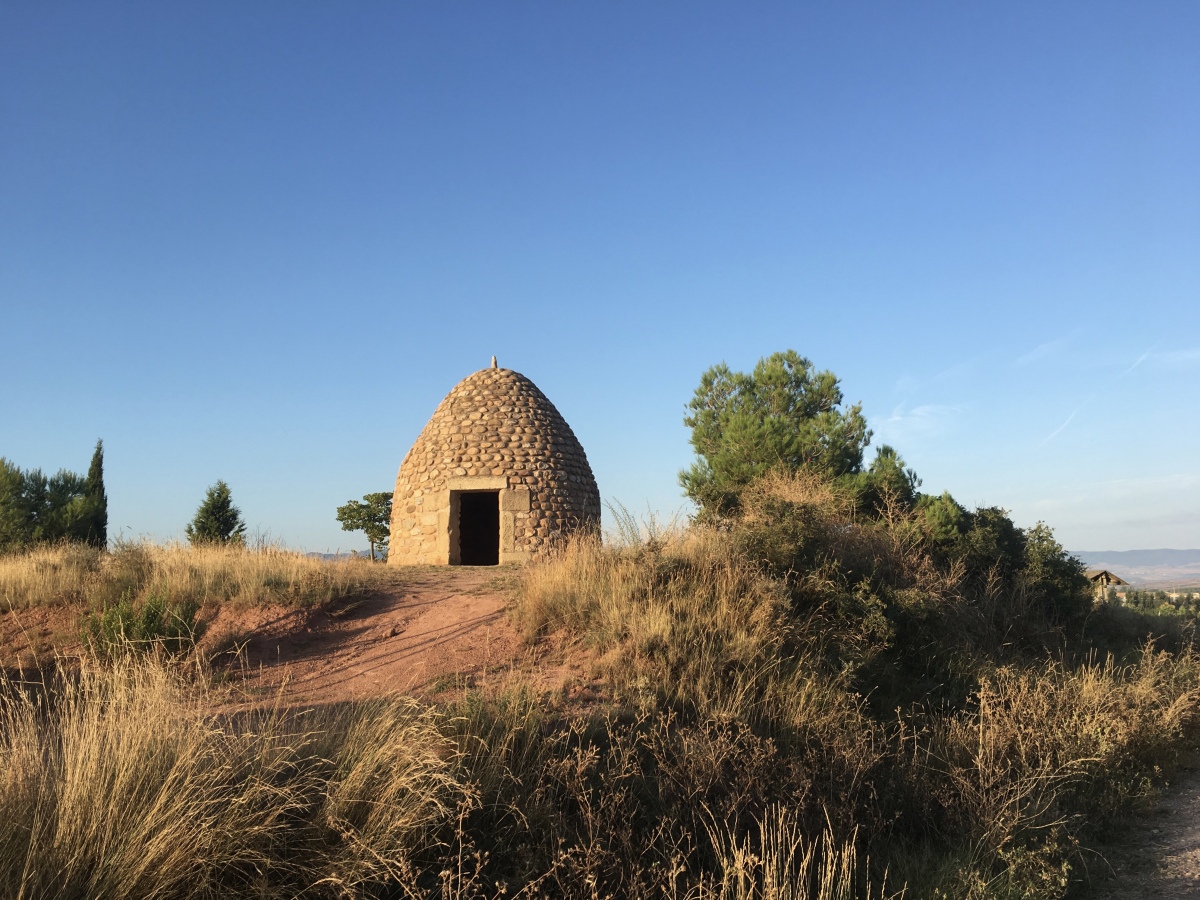
Roldan’s Hill, Poyo de Roldán (8:43 a.m.)
After Roldán’s Hill, the air was swirling with the stench of animal dung and annoying flies, attracted by the salty sweat coating my face. I couldn’t imagine doing the Camino in summer.
The outskirts of Nájera were a mix of vineyards and modern industrial buildings, including a sports center. I enjoyed the cute little cafes and signs welcoming pilgrims. We passed the Convento las Clarisas de Santa Elena, built in the 16th century. It is inhabited by a cloistered community of Franciscan Clarists. Shortly, we crossed a bridge over the río Nájerilla; it had replaced a medieval bridge erected by the Spanish priest and hermit San Juan de Oretga, known as Saint John the Hermit (1080– 1163); he is best known for repairing roads and bridges along the Camino.
Pasarela río Yalde to Nájera (3.2 km)

Peregrino En Nájera (9:26 a.m.)
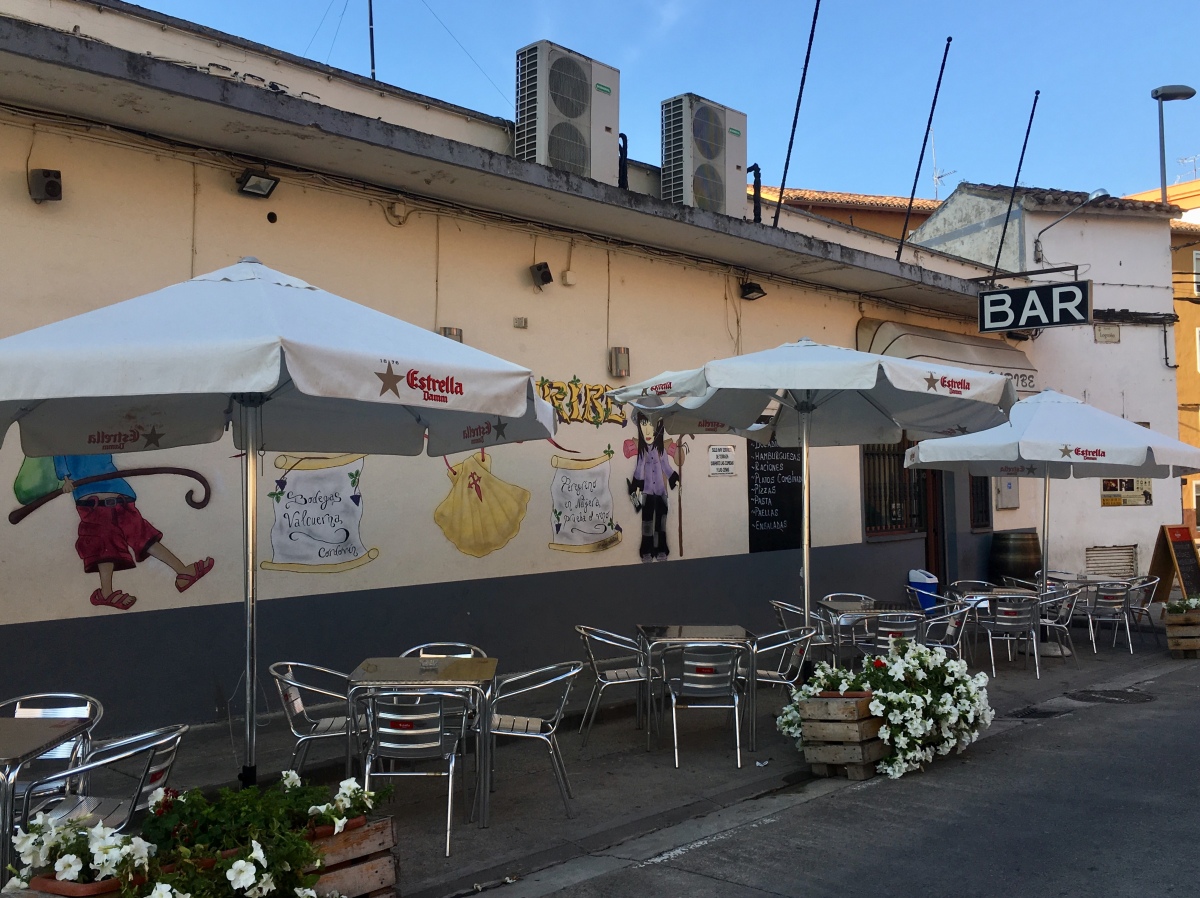
Cafe with pilgrim murals

Cafe with pilgrim murals

Cafe with pilgrim murals

Bridge over río Nájerilla (9:50 a.m.)

Bridge over río Nájerilla

Shell and arrow
I had written in my notes to stop for coffee at the Parador of Santo Domingo, but alas, that was a mistake as I found when I looked around for it in vain. Studying my map, I found that the Parador was in Santo Domingo de la Caldaza. Of course. I would arrive there the following day.
Once I finally got into the heart of Nájera, I liked it. Nájera was known as the Capital of the Kingdom of Navarre in the 11th and 12th centuries and had strong connections to the Camino. In the year 923, King Sancho Garcés I from Pamplona conquered Nájera for Christianity. The expression “Kingdom of Nájera” started being used, especially during the reign of García Sánchez III (1035-1054), since the court from Navarre settled here.
After 1061, Nájera became part of Castile and King Alfonso VI granted some privileges to the township. In 1438, the title of “city” was given and a long and peaceful period ensued until the outbreak of the War of Independence, during which the heritage of the town was greatly damaged. After 1833, Nájera became the administrative center and the headquarters of the district. Currently, it is a dynamic township with a strong furniture industry. It now has an expanding population of 8,500.
Nájera’s old town is located between the river Nájerilla and the Castillo and the Malpica mountain, whose high rock face serves as a dramatic backdrop to the city. In the Middle Ages, both mountains, as well as the city itself, were walled. Its coat of arms, a bridge between two castles, is clearly related to the Road to Santiago and explains the importance of Nájera, one of the few places where pilgrims could cross the Nájerilla. The San Fernando quarter still survives on both sides of the pilgrimage route.
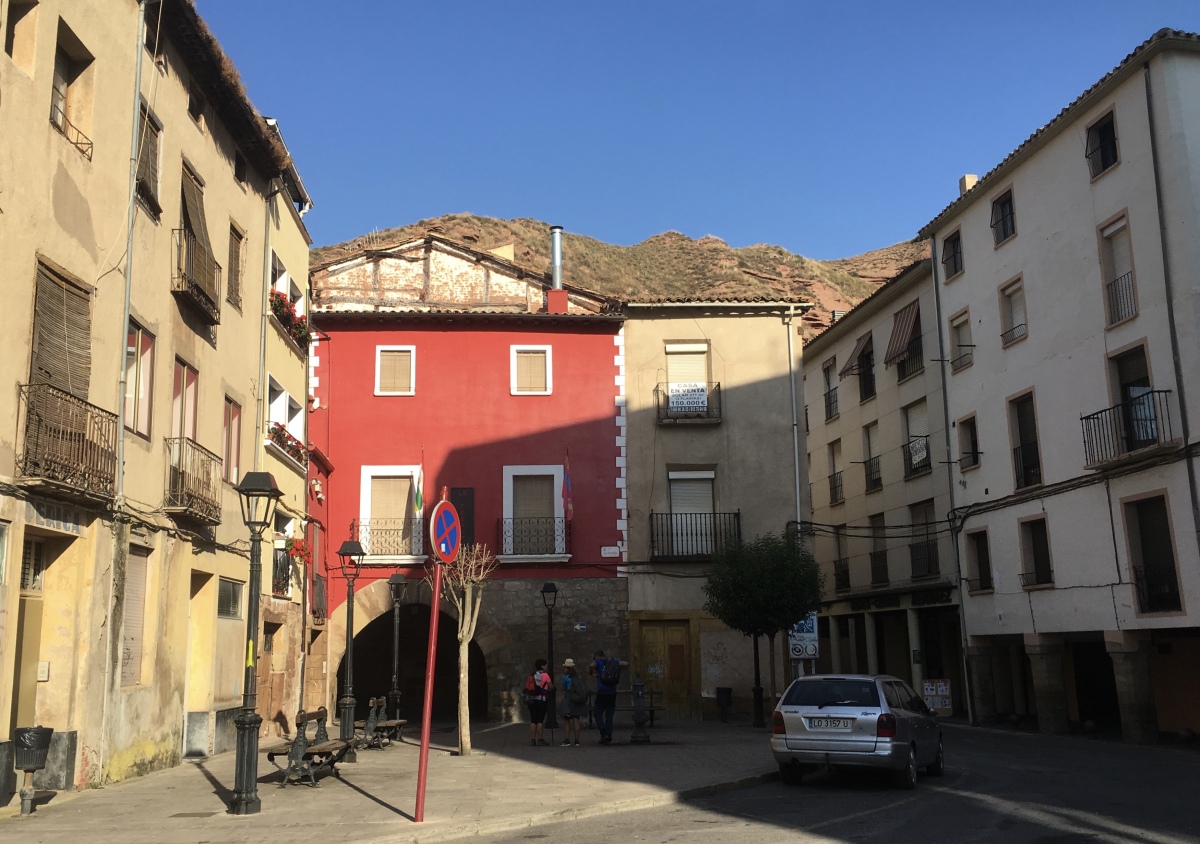
Nájera

Nájera

Nájera
I walked into the Real Parroquia de la Santa Cruz, forgetting it was Sunday, and found parishioners lined up for communion.

Murals in Nájera
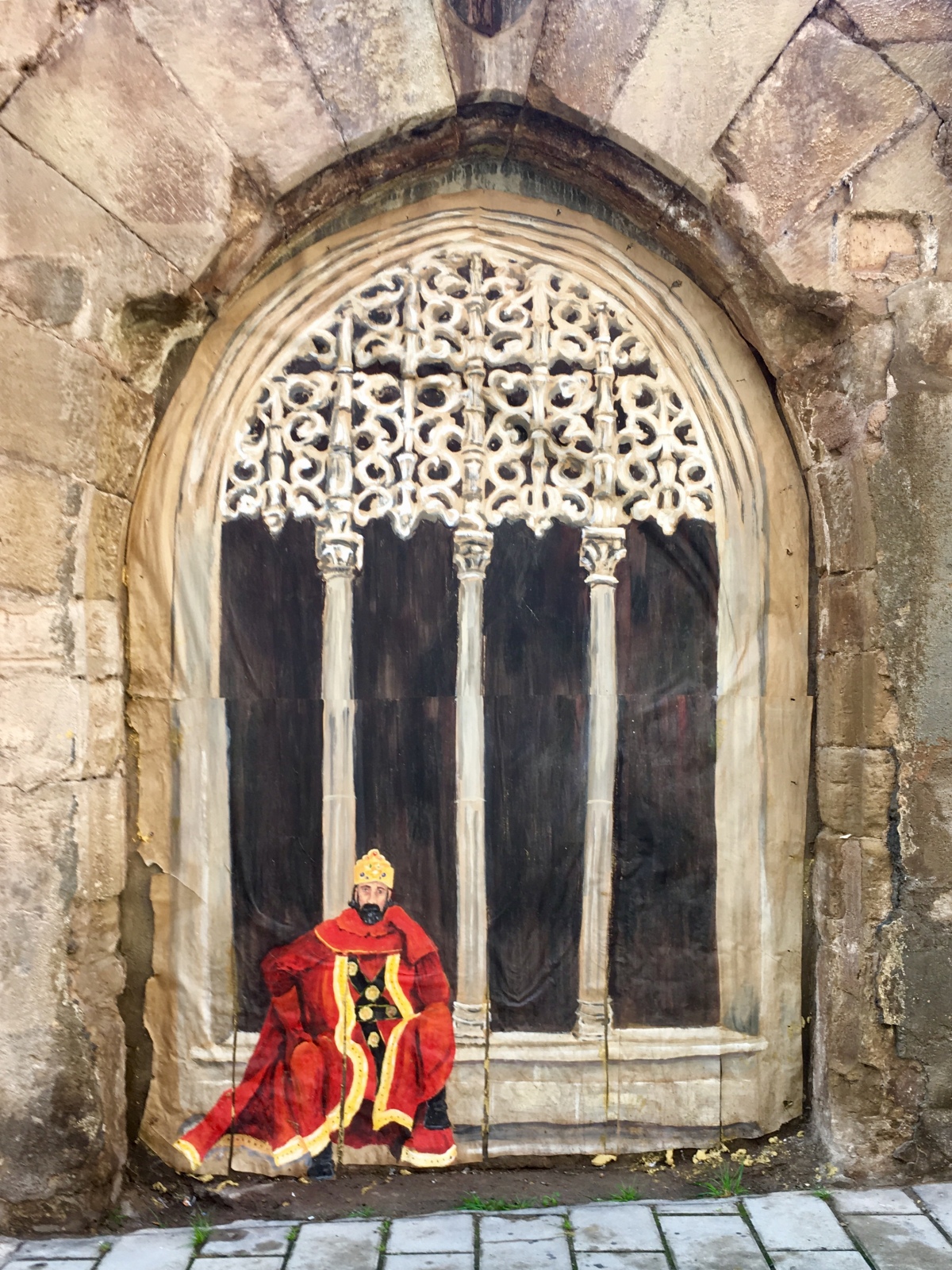
Murals in Nájera

Murals in Nájera
I admired the Monasterio Santa María la Real, founded in 1052. According to legend, in 1044, King García was chasing his falcon while hunting for partridge when, all of a sudden, he found a cave with a surprising statue of the Virgin. The king understood the discovery as a good omen in his fight against Islam so the following year, he initiated the building of the church.
The Monasterio Santa María la Real owned wide territories and wealth. It underwent difficult times in the 13th and 14th centuries, and splendorous ones as well, like the 15th century when the new church got built and the monastery became independent from the Cluny Order. The 19th century was a difficult period as well. The Peninsular War resulted in attacks and plundering, and the clergymen were expelled from the monastery. It became abandoned due to the forced resignation of Juan Álvarez Mendizábal, a Spanish economist and politician who served as Prime Minister of Spain from 25 September 1835 to 15 May 1836. By 1889, it was declared a National Historic Monument by the government. Since 1895, a community of Franciscan monks have been living in the convent and restoring it.
The Royal Pantheon in the monastery is the burial place of many of the kings, queens and knights of Navarre. In the crypt is the cave which gave rise to the church, with its Gothic statue of the Virgen de la Rosa (Our Lady of the Rose).
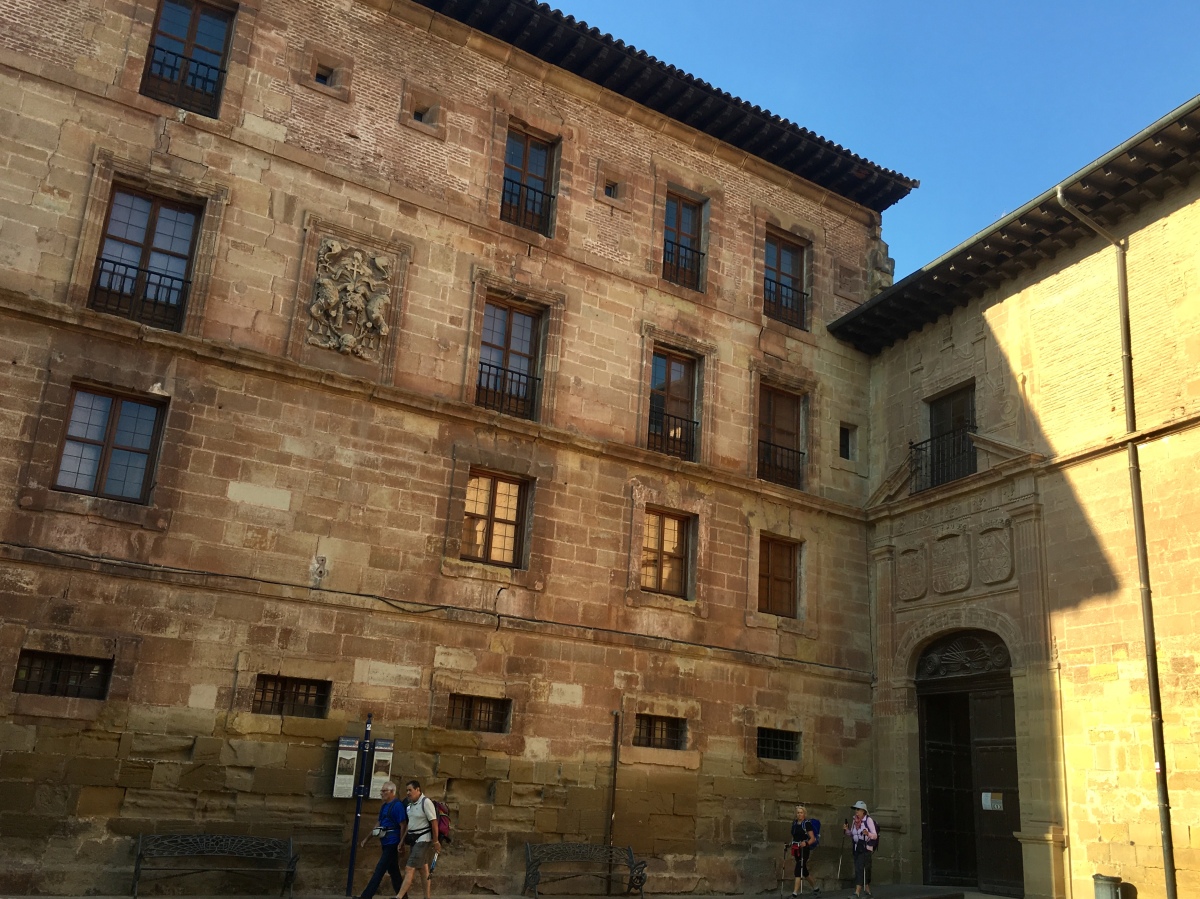
Monasterio Santa María de la Real (10:03 a.m.)

Monasterio Santa María de la Real

Monasterio Santa María de la Real
I continued through Nájera without getting a snack. I found myself at the exit (salida) out of town, trudging uphill on a wide red earth track lined with pine trees. After reaching the high point, the descent was on wide country tracks through gently undulating farmland. It would be 6 km of fairly monotonous landscape from Nájera to Azofra.
It was only 10:45 a.m., and the sun was breathing down my back and neck. Sometimes our walks seemed an eternity; I’d get glimpses of the town ahead, but as I turned corners or crested hills, it never materialized. The flies started once we were in the open. I waved my hiking poles around relentlessly, much like a majorette twirling a baton, to keep them at bay.
As we approached Azofra, I talked with Ann from Indiana. She had quit her job and was taking time to do the Camino and figure out her life. When I told her I was walking and praying for my loved one, she asked if he had mental illness and I said I didn’t know because he’d never been diagnosed. She told of her two brothers, 33 and 34, who were both schizophrenic. They had been committed before and always went off their meds. One was mean and she said what was highly disturbing was that he’d admitted to lusting after her. The other brother was nice but weird. At one time she shared a house with both brothers and their schizophrenic friend. At that moment, her brother lived seven doors down from her and he freaked her out so she had put her house up for sale before leaving home. She thought one brother was bipolar/schizophrenic affective. I wasn’t familiar with that diagnosis.
As we continued walking, Ann, who was in her 30s, told of how she wished she could meet someone special. I told her my daughter felt the same but said the online dating thing was horrible for a person’s self-confidence. Ann thought men were scared off by strong smart women. She had many friends in their 30s who felt the same way.
Nájera to Azofra Centro (6.1 km)

Nájera to Azofra (10:43 a.m.)

The Ezcaray mountains on the southern horizon
Azofra is a small village with a declining population of 250. It seems to exist only because of the Camino.
I arrived at the Refugio Municipal Azofra at 11:30 a.m., an hour before they opened, and soaked my feet with other pilgrims in a little pool in the courtyard. It was so refreshing as it was stinking hot outside. The albergue was basic and didn’t even have enough outlets in which to plug phones. It only had wi-fi in the common area. Once checked in, I showered and did laundry then wandered to the bar in town for French fries and cerveza limon and talked with two easy-going French-Canadian guys, Paul and Richard. I had already chatted with them while we soaked our feet in the pool at the Refugio. I would meet them numerous times between Azofra and Burgos. Paul could speak perfect English but Richard only knew a smattering. However, he asked Paul to translate parts of the conversation so he could participate.

Azofra (11:36 a.m.)

Azofra

Azofra
I shared a room with Keiko, a 71-year-old Japanese woman from Sapporo. She had developed a rash on her chest and arm from an albergue she’d stayed in seven days earlier. She worried the rash might be caused by bed bugs, which made me worry she was carrying them. She wanted to go to the Iglesia Parroquial de Nuestra Señora de los Ángeles with me, so we walked around the outside of the church, dipping inside as a funeral was wrapping up. This church was built of ashlars, or large square-cut stones, and workstone between the 17th and 18th centuries.
We then stopped at an outdoor café where we shared a pilgrim’s meal: white bean soup, fried eggs with chorizo, and flan. We talked to Steffie from Germany who had just divorced her husband because of his alcohol abuse and addiction. She was taking a break from her work and part time job as a yoga instructor. It was a nice conversation, although I felt sorry for Keiko because she could decipher only parts of our English. We tried our best to include her.
I settled in to sleep early so I could get a good start for my next day’s walk to Santo Domingo de la Calzada.

two-bed room at Refugio Municipal Azofra (2:45 p.m.)
Iglesia Parroquial de Nuestra Señora de los Angeles in Azofra (6:10 p.m.) – A statue of Santiago Peregrino (Saint James the Pilgrim) sits inside the church.

Streets of Azofra
*Day 13: Sunday, September 16, 2018*
*27,314 steps, or 11.57 miles: Ventosa to Azofra (16km)*
You can find everything I’ve written so far on the Camino de Santiago here:
**********************
On Sundays, I post about hikes or walks that I have taken in my travels; I may also post on other unrelated subjects. I will use these posts to participate in Jo’s Monday Walks or any other challenges that catch my fancy.
This post is in response to Jo’s Monday Walk.











Ups and downs, for sure, Cathy! Najera looks a nice little place. All depends on your state of mind when you get there, I suppose. I hope things at home are improving. It’s a sad business, but you have to find the positives in it. And you’ve escaped, adventuring again 🙂 🙂 This must seem like ages ago now. Thanks for the link, hon, and Happy Easter!
LikeLike
You’re right about that, Jo. Life is full of ups and downs. This all seems so long ago. Things improve and then nosedive, improve, then nosedive again. I am continually braced for anything these days. Easter didn’t seem much like Easter this year since we were traveling. I hope you had a nice one. 🙂
LikeLiked by 1 person
The window boxes full of blooms are so pretty and must have been a cheery sight along the way.
LikeLiked by 1 person
So many interesting people you meet Cathy. How are your knees holding up to all the walking?
LikeLike
I met so many interesting folks, Pauline. My knees ended up holding up very well, luckily for me! 🙂
LikeLiked by 1 person
Pleased to hear the knees handled the pace
LikeLike
Me too! I really had doubts that I’d be able to do it.
LikeLiked by 1 person
[…] (Camino day 13) Ventosa to Azofra […]
LikeLike
The best part of this journey is the people you meet and how very different they are. I sincerely hope you didn’t get bitten by bed bugs!
LikeLike
I was lucky to avoid the bed bug problem, Jude, thank goodness. The journey and the people I met certainly made it all very interesting! 🙂
LikeLiked by 1 person
Another fascinating account of your daily travails on the Camino enlivened, as always, with gorgeous pictures. I was especially taken with the murals in Najera. The grapes and the vineyards in Rioja reminded me of many happy times I spent in the region and that was a special treat for me. I shall be in Navarra in a few weeks time and will be visiting some of the places you’ve passed through I think.
LikeLike
Thanks, Mari. I loved those murals in Najera. I’m glad the grapes and vineyards in Rioja brought back happy memories for you. I hope you had a grand time in Navarra. 🙂
LikeLike
You have certainly met some real characters along the way! We have just a gloriously sunny Easter weekend. On Good Friday we walked 15 miles. I felt I could hardly put one foot in front of the other by the end and I certainly couldn’t have got up and done it all again the next day. I have renewed admiration for what you have achieved!
LikeLike
I certainly did meet a lot of characters on my journey, Anabel. I’m glad you had a sunny and happy Easter. How nice you got in such a long walk, and I’m glad for you that you didn’t have to repeat it over the following days. 🙂
LikeLike
Yes, we had a lovely sunny, warm Easter, then two weeks later the May Day weekend was freezing cold!
LikeLike
The weather is full of surprises and disappointments at this time of year!
LikeLike
So true!
LikeLiked by 1 person
Another beautiful day. I adore all of those window & terrace flower pots! Bedbugs…ick! It makes my skin crawl just thinking about them!
LikeLike
Thanks, Marsi. I’m sure glad I never encountered the bed bugs that others seemed to encounter, although to be honest, I didn’t hear of many afflictions. 🙂
LikeLiked by 1 person